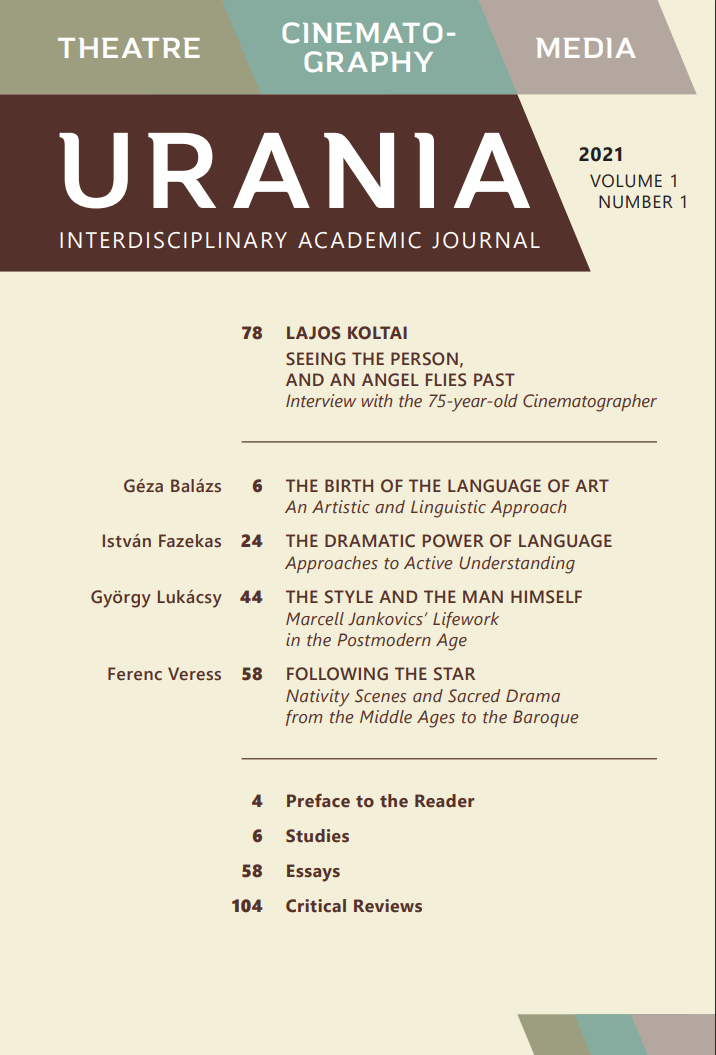The Style and the Man Himself
Marcell Jankovics’ Lifework in the Postmodern Age
Abstract
Marcell Jankovics (1941-2021) was a director of animation films, cultural historian, educator, and culture politician, an outstanding figure of Hungarian animation who won the Golden Palm Award for the best short film with his 1977 work Fighters. Towards the end of his life he often voiced the opinion that in spite of his rich life’s work he had no creative drawing style of his own. The ageing artist’s lament poses the question as to how the work of an artist who disdained post-modernism may contain post-modernist features. This is the question that we intend to examine by scrutinising the series of animation films János Vitéz, based on a narrative poem by Sándor Petőfi, the Tragedy of Man, adapted from Imre Madách’s mankind-poem, and Toldi, based on the epic trilogy by János Arany, as well as the book illustrations. Although the works of Marcell Jankovics are described as post-modernist from a iconographic perspective, his films, and his cultural history works, always point towards a single common (mythical, religious, ritual) logos. Thus, the oeuvre of Marcell Jankovics may be regarded as ‘post-modernist’ only in the sense that he is also characterised by a flair for classicising, that is, he also created a particular canon by way of invoking.
References
Falusi Márton. 2011. „Esszé a fáról, amelyik csak fa akar lenni.” Hitel 2: 54–68.
Fejérvári Gergely, ed. 2009. Jankovics Marcell. Budapest: MMA Kiadó.
Hoppál Mihály. 1998. „Népmese és rajzfilm.” In Folklór és közösség, Hoppál Mihály, ed., 137. Budapest: Széphalom Book Könyvműhely.
Jankovics Marcell. 1996. „Kényszercselekvés és szabad akarat – Vallás és kényszer.” In Ahol a madár se jár, Jankovics Marcell, ed., 198–237. Budapest: Pontifex Kiadó.
Jankovics Marcell. 1987. Csillagok között fényességes csillag. Budapest: Képzőművészeti Kiadó.
Jankovics Marcell. 1996. A Nap könyve. Budapest: Csokonai Kiadó.
Jankovics Marcell. 2018. „A Toldi rajzfilmen.” Magyar Művészet 2: 16–23.
Jankovics Marcell. 2019. „A vizuális nevelésről.” Magyar Művészet 1: 9–17.
Jankovics Marcell. 2019. „Az új Nemzeti alaptantervről.” Magyar Művészet 3: 4–7.
Jankovics Marcell and Méry Gábor. 2000. Felvidéki gótikus templomok. I–XII. album series. Budapest: Méry Ratio Kiadó.
Jankovics Marcell. 2004. „A fehér ló mondája.” In A szarvas könyve, 91. Debrecen: Csokonai Kiadó.
Jankovics Marcell. 2015. „Ha nem halunk bele, nem volt semmi értelme.” Interview with Seres Gerda. Kultúra.hu, 28 May. Viewed 8 August 2010. https://kultura.hu/ha-nem-halunk-bele-nem-volt-semmi-ertelme/
Jankovics Marcell. Küzdők, naphéroszok, alkimisták. Interview with Lukácsy György. Filmvilág, 2021/3. Viewed 8 August 2010. https://filmvilag.blog.hu/2021/05/31/beszelgetes_jankovics_marcellel
Kovács Zsolt. 2001. Hívő vagyok anyám méhétől fogva. Budapest: Kairosz Kiadó.
Lyotard, Jean-François. 1983. „A posztmodern állapot.” In A posztmodern állapot, Jürgen Habermas, Jean-François Lyotard and Richard Rorty, eds., 8. Budapest: Századvég Kiadó.
Panofsky, Erwin. 1984. „Ikonográfia és ikonológia: bevezetés a reneszánsz művészet tanulmányozásába.” In A jelentés a vizuális művészetekben, 252–274. Budapest: Gondolat Kiadó.
Szemadám György. 1987. Jankovics Marcell. Budapest: Corvina Kiadó.
Varga Zoltán. 2019. „Sziszifusz a csúcson – Jankovics Marcell animációs filmjei.” In Jankovics Marcell, Fejérvári Gergely, ed., 48–49. Budapest: MMA Kiadó.




